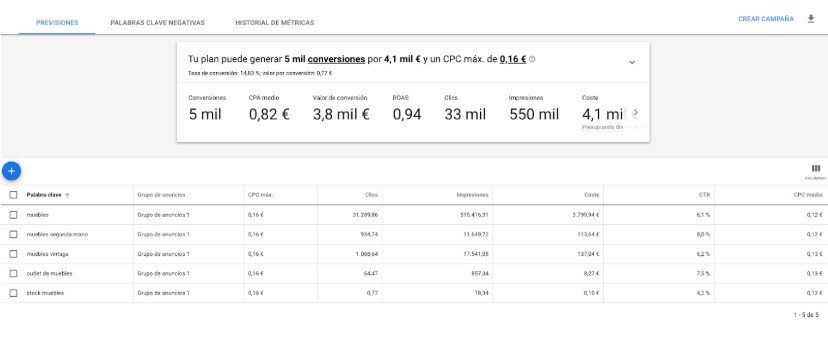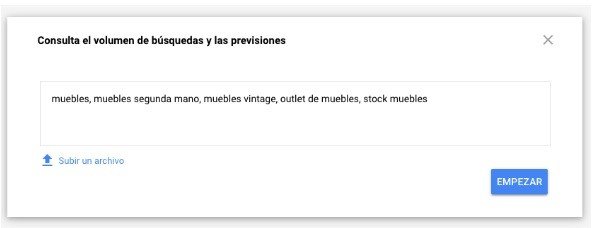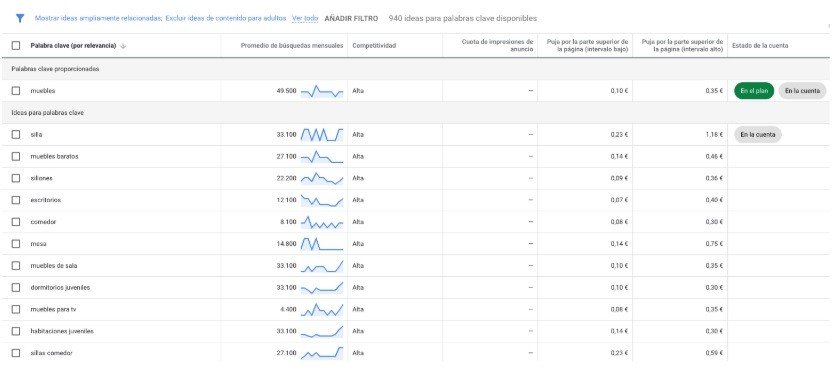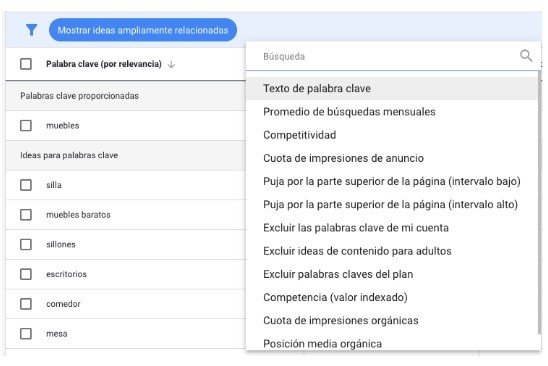Guía PRO de Google Ads Keyword Planner. Sácale el jugo
Si las bolas del desierto han empezado a correr por esta sección de tu interfaz, ¡prepárate para sorprenderte! Google Ads Keyword Planner está mejor que nunca, así que ponte cómodo y entra en su terreno. El conocimiento de la estacionalidad de tus campañas puede salvarte de ahogarte y llevarte a la cresta de ola si sabes aprovecharlo.
Existen muchas herramientas con las que podemos hacer un estudio de palabras clave, y que seguramente ya conocerás: SEMRush, Google Trends, Ubersuggest, Google Correlate… pero hoy queremos centrarnos sólo en una de ellas: el planificador de palabras clave de Google Ads.
El conocimiento de las tendencias de búsqueda en nuestro mercado es vital para el éxito de nuestras campañas. Por ejemplo, en algunos sectores el verano es sinónimo de vacas flacas mientras que otros hacen literalmente su agosto. Y a otros tantos les asaltan las dudas en este momento ¿debería vender más en verano? ¿o menos? ¿las vacaciones implican descenso en el volumen de búsquedas? El estudio de la estacionalidad nos permitirá responder a estas preguntas y aventajarnos sobre nuestros competidores, o concentrar esfuerzos cuando más vale la pena.
Hoy te voy a mostrar cómo el planificador de palabras clave de Google Ads es una herramienta imprescindible que te proporcionará nuevas ideas y estimaciones de tráfico que te permitirán crear campañas de éxito en el momento adecuado.
Funcionalidades de Google Ads Keyword Planner
En los últimos tiempos el Google Ads Keyword Planner ha cambiado bastante, siendo cada vez más útil y además, completamente gratuita.
En esta guía te vamos a explicar sus nuevas funcionalidades, ¡hemos querido esperar el momento perfecto para contarte nuestros hallazgos!
1. Tendencia del volumen de búsqueda
Ten en cuenta que la tendencia del volumen de búsqueda que nos enseña el planificador de Google Ads incluye las búsquedas mensuales promedio de las ideas de palabras clave que aparecen debajo del término de búsqueda.
Esta función no nos propondrá nuevas palabras clave, si no que nos hará una estimación de las que nosotros queramos, por tanto debemos tener bien definidas nuestras keywords.
La herramienta te da la opción de introducir esas palabras clave o subir directamente un archivo.

2. Nuevas ideas de palabras clave
Gracias a esta herramienta podrás descubrir nuevas palabras clave y nuevos grupos de anuncios en función de los términos que describen tu producto o servicio, tu sitio web o una categoría de producto relacionada con lo que anuncias.
También puedes subir una lista inicial de palabras clave y la herramienta te proporcionará una nueva lista con la combinación de todas ellas.
En las siguientes imágenes puedes verlo en la práctica a partir de la palabra “mueble”, que sería en este ejemplo nuestro principal término, y el producto que nos define.
Además, también puedes filtrar este listado según distintas métricas, como puedes ver en la siguiente imagen.
Los filtro más útiles son:
- Texto de palabra clave: te permite indicar qué término que quieres que incluya la palabra clave o al contrario, excluir todos los que lo contengan.
- Promedio de búsquedas mensuales: por ejemplo si solo quieres que te muestre palabras clave con una gran cantidad de búsquedas mensuales, como > 5000.
- Puja por la parte superior de la página: te muestra un cálculo estimado de la puja de CPC necesaria para que tu anuncio aparezca en la parte superior de la primera página (4 primeras posiciones) de los resultados de búsqueda cuando en una búsqueda se utiliza exactamente dicha palabra clave.
- Competitividad: te permite clasificar las palabras clave con un nivel de competitividad “alta”, “media” o “baja”.
3. Segmentación
Segmentar a tu audiencia es muy importante, por tanto para que estas previsiones estén lo más cerca posible de la realidad, debes especificar en la herramienta los siguientes apartados:
- Ubicación objetivo donde quieres centrarte.
- Idioma en el que quieres que aparezcan tus anuncios.
- Redes de búsqueda, o partners como Google Maps, Google Shopping o YouTube.
4. Tendencias de móviles y desglose por dispositivos
El planificador nos muestra también las tendencias de búsqueda en dispositivos móviles. Por ejemplo en verano los dispositivos móviles se usan más porque la gente suele estar fuera de casa, de vacaciones o ¡de parranda!, y no pasan tanto tiempo frente al ordenador.
En julio y agosto, por ejemplo, las búsquedas de cajero cercano desde móvil se sitúan en un 41,5%, la máxima proporción desde estos dispositivos en todo el año:
5. Desglose por ubicación
Podemos desglosar en varios niveles: provincia, Comunidad Autónoma, municipalidad, ciudad o incluso nuestras propias ubicaciones de segmentación. Con el Google Ads keyword planner conoceremos el rendimiento geográficamente.
Aquí vemos un ejemplo con «estudiar master online». Madrid, Barcelona y Sevilla muestran porcentajes significativos, mientras que la mayor parte de las búsquedas están dispersas en otras ciudades.
6. Nuevas oportunidades
Gracias a esta herramienta y teniendo como referencia términos más genéricos puedes investigar qué palabras clave se están posicionando o cuáles son los términos de búsqueda utilizados.
A partir de ellos podrás observar el promedio de búsquedas mensuales y la competitividad de las palabras clave para identificar oportunidades de keywords con poca competencia y con búsquedas elevadas.
Y vamos con la pregunta del millón…
7. ¿Cuándo deberás hacer uso del planificador del Google Ads keyword planner?
Deberíamos utilizar esta herramienta más a menudo en nuestra gestión de cuentas, pero en una serie de casos es imprescindible y obligatoria, ¡palabra de Account Manager!
-
Trabajar el SEO
Es recomendable trabajar los títulos H1, los H2 y las metadescripciones para conseguir un buen posicionamiento SEO. En todos ellos es importante que aparezcan las keywords detectadas en un estudio de palabras clave.
-
Crear contenido
Para redactar el contenido de una web, las descripciones de los productos o las entradas del blog también es necesaria la utilización esta herramienta.
Solo utilizando keywords con un buen promedio de búsquedas conseguirás posicionarte en los buscadores.
-
Crear campañas en Google Ads
Y la última y más importante (con permiso de nuestros compañeros del equipo de SEO y diseño), a la hora de crear nuevas campañas en Google Ads, cuando sí o sí será necesario un estudio de palabras clave previo.
Las campañas de búsqueda de Google Ads funcionan a partir de los términos de búsqueda que los usuarios utilizan. Para detectar qué palabras usan los usuarios, ya sean long tail o short tail, y por tanto crear campañas en Google Ads, será necesario el keyword planner.
A modo resumen, te especificamos en unas líneas las mejoras más recientes de esta herramienta, que los gestores de cuentas llevamos tiempo pidiendo, y ¡por fin nos han escuchado:
- Más palabras clave semilla: introduce hasta 10 palabras clave semilla cuando busques ideas nuevas.
- Tendencias de palabras clave: consulta o descarga las tendencias de ideas para palabras clave concretas.
- Ideas agrupadas: consulta palabras clave por tema o añádelas todas como grupo de anuncios.
- Guarda ideas en campañas que ya tengas: añade ideas nuevas a campañas que ya has creado.
- Presupuesto recomendado: consulta el presupuesto diario recomendado a partir de la puja de CPC máximo y el coste previsto.
- Columna de valor de competencia: consulta la clasificación detallada de la competitividad de las ideas para palabras clave.
Esperamos que este post te haya sido de ayuda para saber cómo utilizar el planificador de palabras clave de Google Ads.
Por supuesto, la plataforma cuenta con más funcionalidades y opciones, pero aquí dejamos que saques tu naturaleza exploradora e investigues por tu cuenta. ¡Los verdaderos SEM Managers lo hacen!
¡Es el momento de realizar tu propio estudio de palabras clave! ¡Ya nos contarás!









